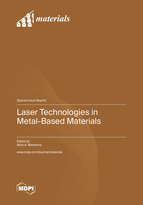Laser Technologies in Metal-Based Materials
A special issue of Materials (ISSN 1996-1944). This special issue belongs to the section "Advanced Nanomaterials and Nanotechnology".
Deadline for manuscript submissions: closed (20 November 2022) | Viewed by 20994
Special Issue Editor
Interests: laser-induced chemical reactions; laser–matter interaction; laser synthesis and modification of nanostructures; metal and hybrid metal–carbon nanostructures
Special Issue Information
Dear colleagues,
The creation of laser served as the foundation for several new scientific fields, such as laser physics, laser chemistry, laser material science, and laser medicine and surgery. Fundamental achievements in these areas, in turn, formed the ground for several laser-related technologies, which are currently dominating many modern industries and are often considered a more efficient solution compared to other options. In addition, laser technologies remain a highly advanced science-based area, which is under continuous refinement and development.
Numerous modern-day knowledge-intensive instruments and devices are based on various phenomena related to metal nanostructures, such as the plasmonic properties of metal nanoparticles and the related effects of electromagnetic field enhancement. Some other good examples would include surface-enhanced Raman spectroscopy, metal-enhanced fluorescence, surface plasmon amplification by stimulated emission of radiation (SPASER), nano-antenna effects, etc. Another group of phenomena occurs as a consequence of the charge transfer and energy conversion processes being affected by a specific surface area of metal nanostructures and by the type of metal and/or metal combination. These phenomena are of great importance as a fundamental background in novel electrochemical sensors, light energy conversion and charge storage systems, etc. Thus, devices based on metal nanostructures provide advanced solutions for a wide spectrum of problems in electronics, optoelectronics, photonics, diagnostics and theranostics, drug delivery, various types of catalysis, and so on.
This Special Issue aims at bringing the fields of laser technologies and metal nanostructures together for the benefit of both. We shall cover here all different aspects, from laser technologies of synthesis of metal-based functional nanomaterials to technologies originating from interaction of laser light with metal-based nanostructures.
It is my pleasure to invite you to submit a manuscript for this Special Issue. Full papers, communications, and reviews are all welcome.
Prof. Dr. Alina A. ManshinaGuest Editor
Manuscript Submission Information
Manuscripts should be submitted online at www.mdpi.com by registering and logging in to this website. Once you are registered, click here to go to the submission form. Manuscripts can be submitted until the deadline. All submissions that pass pre-check are peer-reviewed. Accepted papers will be published continuously in the journal (as soon as accepted) and will be listed together on the special issue website. Research articles, review articles as well as short communications are invited. For planned papers, a title and short abstract (about 100 words) can be sent to the Editorial Office for announcement on this website.
Submitted manuscripts should not have been published previously, nor be under consideration for publication elsewhere (except conference proceedings papers). All manuscripts are thoroughly refereed through a single-blind peer-review process. A guide for authors and other relevant information for submission of manuscripts is available on the Instructions for Authors page. Materials is an international peer-reviewed open access semimonthly journal published by MDPI.
Please visit the Instructions for Authors page before submitting a manuscript. The Article Processing Charge (APC) for publication in this open access journal is 2600 CHF (Swiss Francs). Submitted papers should be well formatted and use good English. Authors may use MDPI's English editing service prior to publication or during author revisions.
Keywords
- laser-assisted technologies
- laser-induced processes
- metal-based functional nanomaterials
- metal nanostructures
- plasmonic materials







